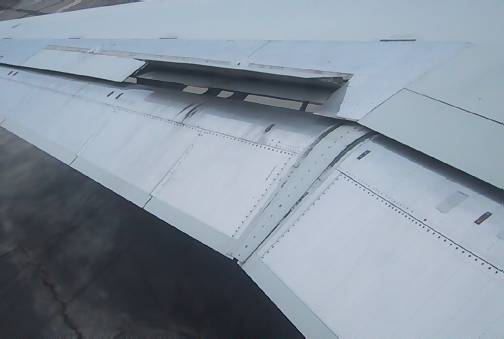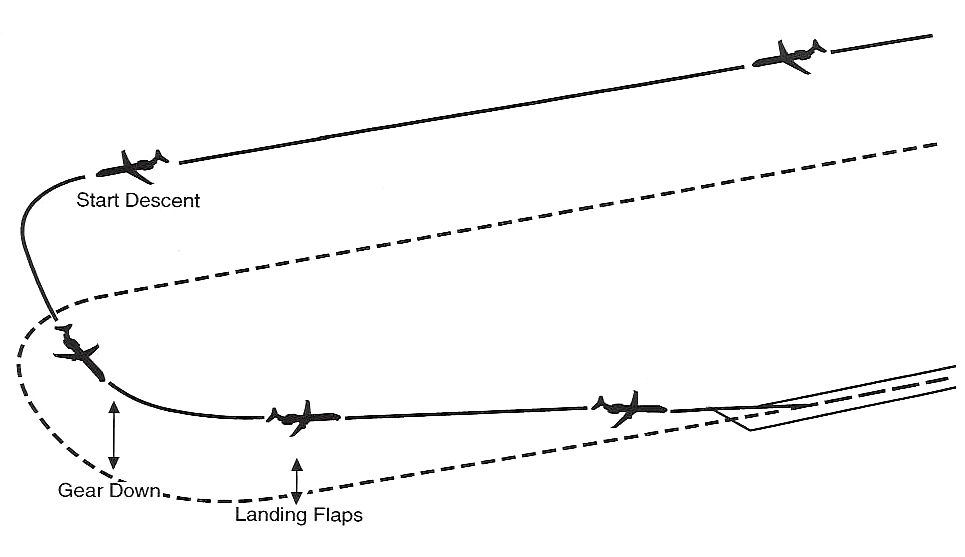Lesson 5: Your Virtual Practice Flight
Part 2 - The Takeoff
(Approx. time to complete: 10 minutes.)
- Copyright N Bamforth
-
Listen to my short narrative about takeoffs.
Takeoff
Once the Takeoff Checklist is complete and the plane is lined up on the runway, the pilots apply power. You will hear a little "roar" as the jet engines spool up.
As you travel down the runway you may feel small bumps, this is from the runway surface and the runway centerline lights. You may also hear or feel a slight vibration from the plane's wheels as they spin up to speed.
The takeoff roll down the runway is normally about 20 seconds. The lightweight interior panels and fascia may rattle and vibrate a little at first. After a few moments the nose of the plane will tilt up and everything gets quieter and smoother as you lift off.
Sometimes it may feel like the plane is climbing too steeply. People have asked me if the plane could slide back down or tilt over backwards when the plane climbs so steeply. The answer is no, that won’t happen, never has, never will. The steep angle is normal because it enables us to climb rapidly to smoother and more fuel efficient altitudes. Don't worry about the steep angles, that just means your plane has a lot of excess power.
- Video by Tony Marsh
During Takeoff
During takeoff you may hear a clunk when the plane’s nose tilts up and you lift off. That’s the landing gear shock absorber extending to its limit. The plane is designed to allow for a steep lift off. You may worry the tail will drag on the runway. That is very rare, besides there is something called a “tailskid” which protects it.
If you are sitting near the wings you may hear some whirring and bumping noises from the hydraulics and the thump of the landing gear retracting. If you are near the front of the plane you may hear the thump of the nose gear retracting. During the gear retraction the gear doors open and close adding to the sounds you will hear.
Shortly after takeoff you may feel a sinking sensation, that happens when the flaps are retracted, allowing the plane to accelerate. You may also hear the engines throttle back, sometimes ATC asks us to level off because traffic is above us. Once clear we will add power and continue climbing.
You may also notice the plane "banking" or turning shortly after takeoff. That's normal, we're just following ATC instructions or turning toward our destination.
During takeoff see if you can enjoy the feel of acceleration. These jet airliners have lots of power and can really move! That's good, imagine if your car could merge onto the freeway with power like that!
Listen to sounds of the liftoff.
Some people worry that an engine might quit. Engine failures are extremely rare, but as with everything else, the pilots are prepared. Engine failures are practiced routinely in training. The engine failure training drills are so demanding that if an engine really does fail it is easy to just circle around and land again.
The FAA mandates that even with an engine out on the takeoff run the plane must still be able to lift off, clear all obstacles by a wide margin, and comfortably return for landing. Each takeoff is planned so that if an engine fails the pilots can either have plenty of room to stop, or continue to takeoff safely.
Next you might hear another "ding" or short PA notifying the flight attendants it is safe to leave their seats. You stay put though, until the Seatbelt Sign is turned off. Shortly after takeoff is a good time for sightseeing.
The Climb Out & Cruising
Here's a little suggestion - If you are a little sleepy after takeoff, now is a great time to snooze. With the airplane tilted upward in the climb your seat will feel like a recliner.
You might hear another "ding" when passing 10,000 feet, this alerts the flight attendants that the cockpit "sterile" period is over. The FAA requires the pilots to remain focused during takeoff and landings.
Listen to the sound of cruise flight
Now it is finally time to relax and entertain yourself. Your flight can be quite enjoyable if you do it right. If you don't feel like sleeping you have lots of stuff to do. Snack, read, listen to music, look at pictures, chat with your seat-mate, and watch an in-flight movie. At some time you might want to stretch your legs and visit the lavatory.
If you're kids are along have them draw pictures for the pilots. We love getting drawings from kids as they get off the plane.

It is normal to be concerned about turbulence, many people are. Try setting a cup of water on your tray table in front of you. Watch the water, chances are it won't spill. Often your senses are heightened and it really isn't as bumpy as you think. Drinks rarely spill in flight. Do the same thing in your car you'll most likely get wet!
I know that it is difficult, but if you encounter turbulence please don't worry. Even strong turbulence is harmless. For the most part flying is very smooth, after all, you are riding on air!
Destination Arrival
Descent
About 30 minutes from landing the plane will start it's descent. You should like this part, because now you're almost at your destination. Soon the seatbelt sign will be turned on again.
After takeoff it may be a little bumpy due to hot air rising from the sun warming the ground. This type of turbulence is normally mild, but soon after takeoff you will be above this haze layer the air will smooth out.
You may feel some pressure build in your ears as the air gets thicker. To relieve air pressure buildup in your ears you can yawn or swallow. You can also plug your nose, close your mouth, and blow gently. This will make a little popping sound in your ears, but it feels good.

Approach
During approach for landing the pilots will need to slow down to fit into the traffic flow. To do this they may extend the speed brakes, the large panels on the top of the wings. These panels block airflow over the wing causing drag. You may feel a slight buffeting or vibration while slowing down.
Listen to the sound of air after the gear is lowered.
If a landing is discontinued for reasons such as conflicting traffic, weather, or runway obstacles, it is called an aborted landing (also called rejected landing, missed approach, or go around).
An aborted landing can upset passengers who don’t understand what is happening. Aborted landings are rare, but you should know that the crew is doing the right thing for safety. When pilots abort a landing they will add power, start climbing, and retract the landing gear and flaps. Depending on the reason for the aborted landing, they will return for another approach, hold, or divert to a nearby airport. Pilots are well trained for these events and you shouldn’t be concerned.
Your checklist is about complete, the pilot's checklist is complete, "cleared for landing!"
You're Almost Finished!
CLICK HERE TO CONTINUE TO LESSON 5- Part 3